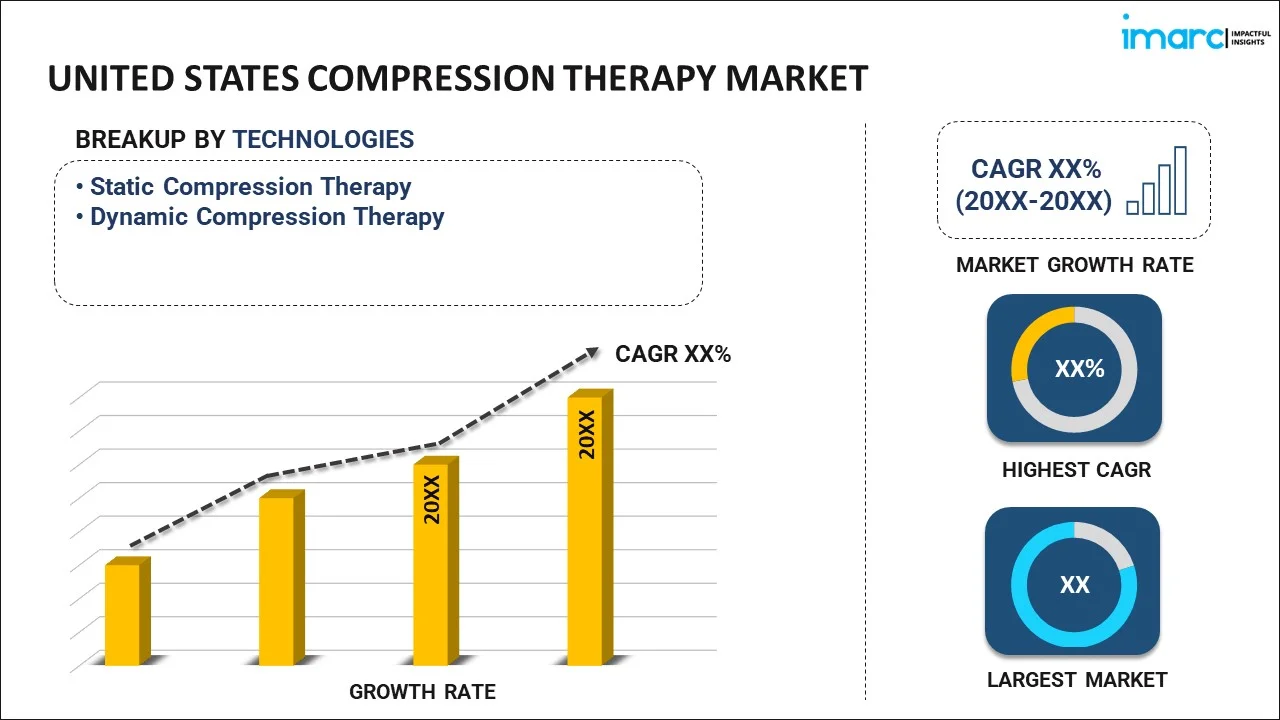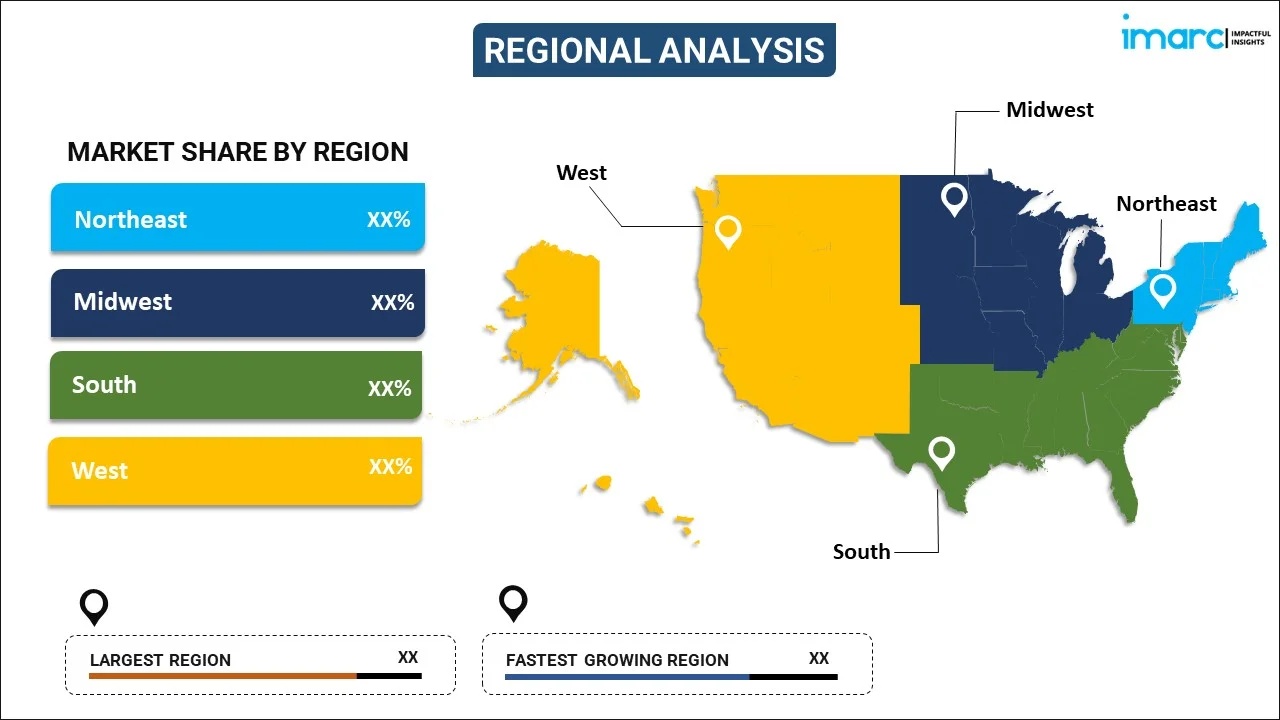
United States Compression Therapy Market Report by Technology (Static Compression Therapy, Dynamic Compression Therapy), Product (Compression Pumps, Compression Stockings, Compression Bandages, Compression Tape), Application (Lymphedema Treatment, Leg Ulcer Treatment, Varicose Vein Treatment, Deep Vein Thrombosis Treatment, and Others), and Region 2025-2033
Market Overview:
United States compression therapy market size reached USD 1.1 Billion in 2024. Looking forward, IMARC Group expects the market to reach USD 1.7 Billion by 2033, exhibiting a growth rate (CAGR) of 5.28% during 2025-2033. The growing technological advancements in material science, rising geriatric population that is more susceptible to venous disorders, such as deep vein thrombosis (DVT), varicose veins, and lymphedema, and increasing stringent regulatory compliance represent some of the key factors driving the market.
|
Report Attribute
|
Key Statistics
|
|---|---|
|
Base Year
|
2024
|
|
Forecast Years
|
2025-2033
|
|
Historical Years
|
2019-2024
|
|
Market Size in 2024
|
USD 1.1 Billion |
|
Market Forecast in 2033
|
USD 1.7 Billion |
| Market Growth Rate 2025-2033 | 5.28% |
Compression therapy is a medical treatment that involves the use of specialized garments or devices to apply controlled pressure to specific areas of the body, typically the limbs. It consists of various garment types, such as stockings, sleeves, wraps, and bandages, designed to target specific areas of the body. It comes in several types, including static, dynamic, and intermittent pneumatic compression, each serving distinct therapeutic needs. It helps prevent blood clots, reduces swelling, and promotes healing by enhancing blood and lymphatic flow. It can alleviate pain and discomfort associated with various medical conditions, improving the quality of life for patients. It aids in maintaining or improving mobility, allowing individuals with conditions like venous insufficiency to lead more active lives. It can expedite the healing process, especially in cases of wound care and post-surgical recovery. It is utilized across a wide range of medical conditions, including lymphedema management, chronic venous insufficiency, and post-thrombotic syndrome.
United States Compression Therapy Market Trends:
At present, the rising geriatric population that is more susceptible to venous disorders, such as deep vein thrombosis (DVT), varicose veins, and lymphedema, represents one of the crucial factors impelling the growth of the market in the United States. The increasing prevalence of chronic venous disorders (CVD) due to factors like obesity and sedentary lifestyles is also contributing to the market growth in the country. Besides this, the growing technological advancements in material science are leading to the development of more comfortable, durable, and effective compression garments. Moreover, the rising integration of smart technologies, such as wearable compression devices with the internet of things (IoT) capabilities, is allowing better monitoring and adherence to compression therapy, thereby enhancing the effectiveness of treatment. In addition, the increasing awareness about the benefits of compression therapy due to educational campaigns by healthcare providers and manufacturers is supporting the market growth. Furthermore, there is a rise in the employment of compression therapy in sports and fitness for better muscle support and reduced fatigue. This, coupled with the growing awareness about the benefits of compression wear in enhancing athletic performance and recovery, is positively influencing the market in the country. Apart from this, the increasing number of online platforms that offer a wide range of products, often at competitive prices, is making it easier for buyers to access various innovative compression therapy products. The convenience of online shopping, coupled with the ability to compare products and read reviews, is encouraging more people to purchase compression therapy items online. Additionally, the rising implementation of stringent approval processes for ensuring the safety and efficacy of compression therapy products is strengthening the market growth.
United States Compression Therapy Market Segmentation:
IMARC Group provides an analysis of the key trends in each segment of the market, along with forecasts at the country level for 2025-2033. Our report has categorized the market based on technology, product, and application.
Technology Insights:

- Static Compression Therapy
- Dynamic Compression Therapy
The report has provided a detailed breakup and analysis of the market based on the technology. This includes static compression therapy and dynamic compression therapy.
Product Insights:
- Compression Pumps
- Compression Stockings
- Compression Bandages
- Compression Tape
A detailed breakup and analysis of the market based on the product have also been provided in the report. This includes compression pumps, compression stockings, compression bandages, and compression tape.
Application Insights:
- Lymphedema Treatment
- Leg Ulcer Treatment
- Varicose Vein Treatment
- Deep Vein Thrombosis Treatment
- Others
The report has provided a detailed breakup and analysis of the market based on the application. This includes lymphedema treatment, leg ulcer treatment, varicose vein treatment, deep vein thrombosis treatment, and others.
Regional Insights:

- Northeast
- Midwest
- South
- West
The report has also provided a comprehensive analysis of all the major regional markets, which include Northeast, Midwest, South, and West.
Competitive Landscape:
The market research report has also provided a comprehensive analysis of the competitive landscape in the market. Competitive analysis such as market structure, key player positioning, top winning strategies, competitive dashboard, and company evaluation quadrant has been covered in the report. Also, detailed profiles of all major companies have been provided.
United States Compression Therapy Market Report Coverage:
| Report Features | Details |
|---|---|
| Base Year of the Analysis | 2024 |
| Historical Period | 2019-2024 |
| Forecast Period | 2025-2033 |
| Units | Billion USD |
| Scope of the Report | Exploration of Historical Trends and Market Outlook, Industry Catalysts and Challenges, Segment-Wise Historical and Future Market Assessment:
|
| Technologies Covered | Static Compression Therapy, Dynamic Compression Therapy |
| Products Covered | Compression Pumps, Compression Stockings, Compression Bandages, Compression Tape |
| Applications Covered | Lymphedema Treatment, Leg Ulcer Treatment, Varicose Vein Treatment, Deep Vein Thrombosis Treatment, Others |
| Regions Covered | Northeast, Midwest, South, West |
| Customization Scope | 10% Free Customization |
| Post-Sale Analyst Support | 10-12 Weeks |
| Delivery Format | PDF and Excel through Email (We can also provide the editable version of the report in PPT/Word format on special request) |
Key Questions Answered in This Report:
- How has the United States compression therapy market performed so far and how will it perform in the coming years?
- What has been the impact of COVID-19 on the United States compression therapy market?
- What is the breakup of the United States compression therapy market on the basis of technology?
- What is the breakup of the United States compression therapy market on the basis of product?
- What is the breakup of the United States compression therapy market on the basis of application?
- What are the various stages in the value chain of the United States compression therapy market?
- What are the key driving factors and challenges in the United States compression therapy System?
- What is the structure of the United States compression therapy market and who are the key players?
- What is the degree of competition in the United States compression therapy market?
Key Benefits for Stakeholders:
- IMARC’s industry report offers a comprehensive quantitative analysis of various market segments, historical and current market trends, market forecasts, and dynamics of the United States compression therapy market from 2019-2033.
- The research report provides the latest information on the market drivers, challenges, and opportunities in the United States compression therapy market.
- Porter's five forces analysis assist stakeholders in assessing the impact of new entrants, competitive rivalry, supplier power, buyer power, and the threat of substitution. It helps stakeholders to analyze the level of competition within the United States compression therapy industry and its attractiveness.
- Competitive landscape allows stakeholders to understand their competitive environment and provides an insight into the current positions of key players in the market.
Need more help?
- Speak to our experienced analysts for insights on the current market scenarios.
- Include additional segments and countries to customize the report as per your requirement.
- Gain an unparalleled competitive advantage in your domain by understanding how to utilize the report and positively impacting your operations and revenue.
- For further assistance, please connect with our analysts.
 Request Customization
Request Customization
 Speak to an Analyst
Speak to an Analyst
 Request Brochure
Request Brochure
 Inquire Before Buying
Inquire Before Buying




.webp)




.webp)












